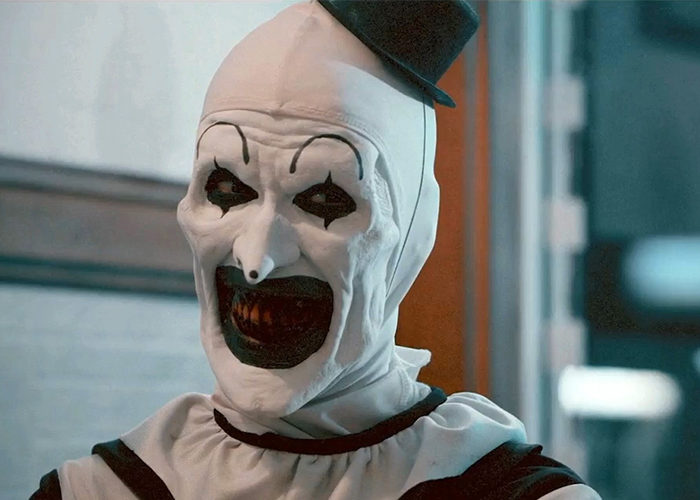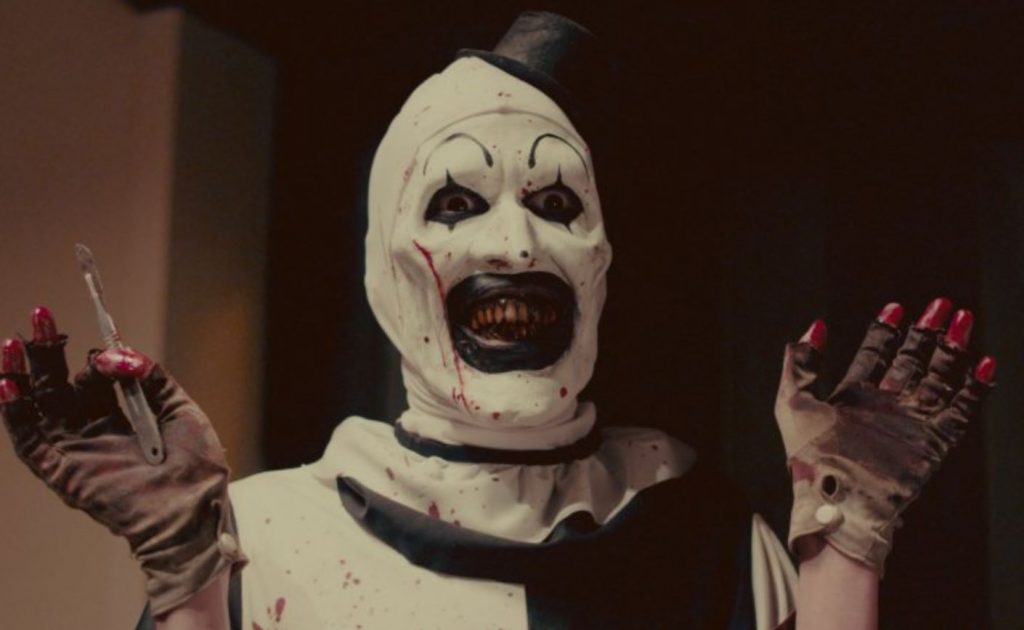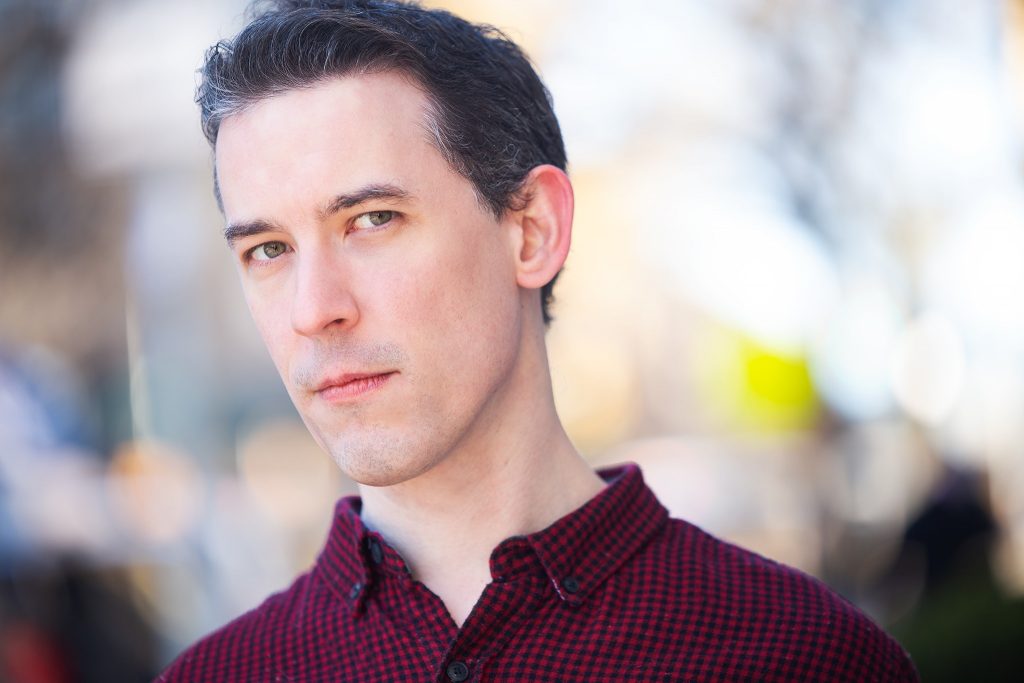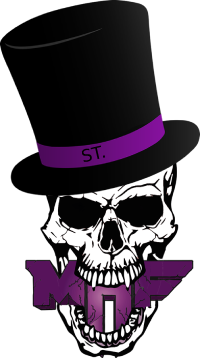
When I say “blood,” I mean aesthetics. The “Canvas” is history, and so the purpose of this review is to provide a fortification-analysis built on metaphor, strongly suggesting that the 2016 film Terrifier is a beacon in the poetic grand scheme. We may just be too close to see it right now; a forest for the tree’s kind of thing. It reminds me of good rock ‘n roll, the type with staying power, the bold kind that isn’t afraid to mix genres, keeping it fresh, yet at the same time making damned sure to celebrate the patterns of the past.
OK, no more bullshit, writer-director Damien Leone is a genius and David Howard Thornton’s portrayal of the murdering circus creature Art the Clown, is no less than brilliant. My point is that the product enjoyed by the end-user is far more than a burst and flare of pop culture. There is tradition here, and both Leone’s directorial choices and Thornton’s amazingly creepy mannerisms and antics, are built on solid historical foundations. T.S. Elliot said, quote: “Past poems condition my response to any new poem. And the really new poem conditions my response to all the poems that preceded it.”
Leone has said on various YouTube podcasts that Terrifier was constructed as a nod to 80’s slashers, those which featured special effects that were “hand-made” (my paraphrase) as opposed to being computer-generated. As inferred in my introduction, I will take the liberty here to offer a distinct parallel between film and rock, and more specifically horror movies linked with hard rock and metal records. No matter how state of the art the tech gets, there are some artists who just prefer to go old school, get their fingers in it, mold the clay. Leone’s kill scenes are epic, outstanding, majestic, pick your adjective. There is love there. Hand crafted and carefully tailored, splatter to splatter, detail for detail. CGI in general reminds me of the first time we heard drum machines in popular music. Yeah, they made for a sort of “perfection,” but it was far more fun to see Keith Moon or John Bonham go pound and explore.
In terms of David Howard Thornton’s portrayal of the grinning, silent, and deliciously vicious killer-clown, he has had many interviews in which he has spoken of his study of past icons. I did indicate that I would provide examples of crossing genres, and it may be best represented here in Thornton’s response when I asked him about influences.
Well, first of all, I watched the original performance by Mike Giannelli several times to get the basic nuances of the character down. Once I did that, I decided to bring my background of physical comedy into the mix which I have cultivated over a life time from watching great physical comedians like Charlie Chaplin, Buster Keaton, Rowan Atkinson, Jim Carrey, Doug Jones, and my friend/mentor Stefan Karl. I decided to do this since 1. Art is a clown and 2. to set Art apart from the other silent slasher villains that came before him that are usually hidden behind a mask. You see Art’s face, so I wanted the viewer to sense what Art was thinking and feeling through his physical expressions, especially his facial expressions even though he does not talk.

I was especially impressed by the former statement concerning Mike Giannelli. In another of my thematic parallels, this reminds me very much of the shock and awe we experienced when Brian Johnson replaced Bon Scott in AC/DC, they who released Back in Black six months after Scott’s demise. Johnson brought his own gifts and style, yet he was clearly aware of what had come before him. He didn’t reject Scott, nor reinvent him, but rather, he mirrored the collective soul of the band. Then he formed a persona that wasn’t just a hood ornament. It had roots. It had credibility. It unselfishly hooked us and made us believers.
Plainly, David Howard Thornton is arguably the greatest scare-clown on film. Notably, he used Gianelli’s work, and also, as quoted, crossed genres to borrow from comedic icons, lending him the opportunity mark his own blood on the mural, the handprint that we’d never forget.
My favorite bits in the film are somewhat shared by many critiques I have read. Of course, I am talking about the pizza shop scene. As often occurs in good horror, the best parts are the nonviolent one’s, and this is no exception. If you haven’t seen the film, look out for it. Art follows two party-girls into a pizza shop, sits across the aisle, and makes faces at one of them. It is awesomely frightening, especially since we all can relate to something odd happening right before our eyes, yet we are too caught up in social etiquette to take action. I asked Thornton about this part of the scene, and he claimed Leone told him to make faces. He left the camera running. Thornton made a bunch, more than three minutes worth, and Leone was smart enough to choose the ones that he did.
I do have to take the opportunity at this point to say that Thornton didn’t do this alone. Not only is the editing of that scene (and the whole movie) pristine, raw, and daring, but the performances of the two young women (Jenna Kenell as Tara and Catherine Corcoran as Dawn) are simply outstanding. There has been some negative press concerning their dialogue and lack of character depth, but I would argue that their work was nearly flawless, strengthening the mosaic, and effectively reinforcing the dramatic arc. I realize that those who have seen the film think I am going to next rave about the upside-down hacksaw scene, but I actually think the two best moments in the film were part of the build-up. Corcoran’s intrusive selfie was absolutely horrifying (in a good way), and it could not have been delivered without her abrasive innocence and Thornton’s deadpan brilliance. My second fave is the shot just before the aforementioned hacksaw scenario, during which Art the Clown tries to get a hold of the hair on top of Tara’s head. She is duct taped to a chair and struggling and he stands over her trying to get a grip with stoic, bald determination, as if studying the pattern of Wack-a-Moles at the carnival. Then, when he does get a handful, he yanks her head back in an almost blissful exposure of Kenell’s neck, hacksaw positioned in front of it, giving us the beautiful vulnerability of the flesh that accents the consummate terror of the blade.
Broadening back to my opening statements, I hope to convince you of the potency of this film when compared with impactful events of the past. Again, when it happens before your eyes in real time, it is more difficult to note the historical significance, so I hope to offer some factoids you’ll see as concurrent.
Think of 1978. For me, I was in my junior year in high school, and February 10th, Van Halen’s debut album was released. Then the next fall I was a senior about to embark upon the world, and October 25th, Halloween hit the theaters.
As for the former, we had never in our wildest dreams imagined that a guitar could be played the way Eddie did it. VH opened for Black Sabbath that year and blew them off the stage. I was there at the Philadelphia Spectrum, and it was a gargantuan loss for Ozzy’s group of tired, strung out veterans who had ironically invented heavy metal, yet couldn’t compare to this super-charged warm-up act. Since there were no Jumbo-Tron screens back then, you couldn’t really see how this “Eddie Han Halen dude” was making those infamous bird-noises, not unless you were in the first twenty rows, and it was actually a month or so later that the guitar player in my cover band would put the pick in his mouth, reach across the neck, and do these two-handed hammer-ons in what is now referred to as “tapping.”
In terms of the latter, Halloween changed my life. I became a horror fanatic and started reading Stephen King books. I would publish my own horror books later in life, but just as this review is so not about me, I am arguing that Halloween did not just appear out of nowhere. Neither did Eddie Van Halen. Returning to the idea illustrated earlier by T.S. Elliot concerning the idea that the new artists with staying power have always connected in some way with masters of the past, Eddie Van Halen listened to classical. He also did not invent “tapping.” Roy Smeck did in the 1930’s, and he did it on the ukulele.

Concurrently, John Carpenter didn’t invent the slasher. Of course, this is such obvious common knowledge it almost “goes without saying,” but many argue that horror-slashers all harken back to Psycho, 1960. Makes sense, doesn’t it? And being that I have meta-textually “themed” this review as a sort of celebration of the rhetorical devices themselves, let’s add the fact that Janet Leigh got stabbed in the shower just like her daughter Jamie Leigh Curtis got pawed at in the closet eighteen years later. The connections are startling, but at the same time not surprising. Additionally, my theory about teamwork holds true. Psycho’s shower scene would not have been nearly as good without Bernard Herrmann’s maniac violins, and Jamie Lee wouldn’t have been as sympathetic without all the cleverly crafted scenes using dialogue as rhythmic build-ups for scare-moments. Carpenter used synthesizer stingers as opposed to screeching string instruments, but more importantly, he built on the past not only in dutiful acknowledgment, but by fucking with the sound levels, recording the given scene on level five, yet the sound effect on eight as it coincided with a sudden Michael Meyers sighting. Hence, we got our beloved “Jack-in-the-Box” effect.
My point is that where there is a tree, there are roots, and the projects that thrill us the most show them above ground. The best art connects clearly with the past and then does it one better, emphasizing the overall product as opposed to the player, and with that in mind, I offer one more analogy.
Van Halen was not the ground-breaking phenomenon they were simply because they turned their Marshalls up louder. Their producer, Ted Templeman, knew how to take lightening in a bottle and deliver a game-changer. Same thing with Damien Leone. He just released the teaser-trailer of Terrifier 2, and I don’t just look forward to the glorious hand-crafted kills. I am not simply intrigued by starlet Lauren LaVera’s natural beauty, her skills in martial arts, or the way she’ll portray the world’s next great scream-queen.
I expect to see history. Delivered to all of us in real time.
Michael Aronovitz is a college professor and horror writer. He has published three novels, two collections, and more than fifty short stories. Coming fall of 2021, his fourth novel, a serial killer / mystery titled The Sculptor, will be published by Night Shade / Skyhorse Books. In fall 2021, he will also release a lifetime collection of short fiction titled Dancing with Tombstones. This will be published by Cemetery Dance Publications.


